Analysis of Operation Management and Energy Systems
VerifiedAdded on 2020/10/22
|12
|3322
|423
AI Summary
The assignment delves into the world of operation management and energy systems, exploring concepts such as smart grids, energy management, and demand-side management. It examines different approaches to efficient energy consumption, including system architectures for autonomous load management in smart buildings and stochastic model predictive control for microgrid operation management. The document also touches on the historical review of demand-side management in China, highlighting its management content, operation mode, results assessment, and relative incentives. Furthermore, it discusses bandwidth management with opportunistic networks and public transport planning, management, and operation.
Contribute Materials
Your contribution can guide someone’s learning journey. Share your
documents today.
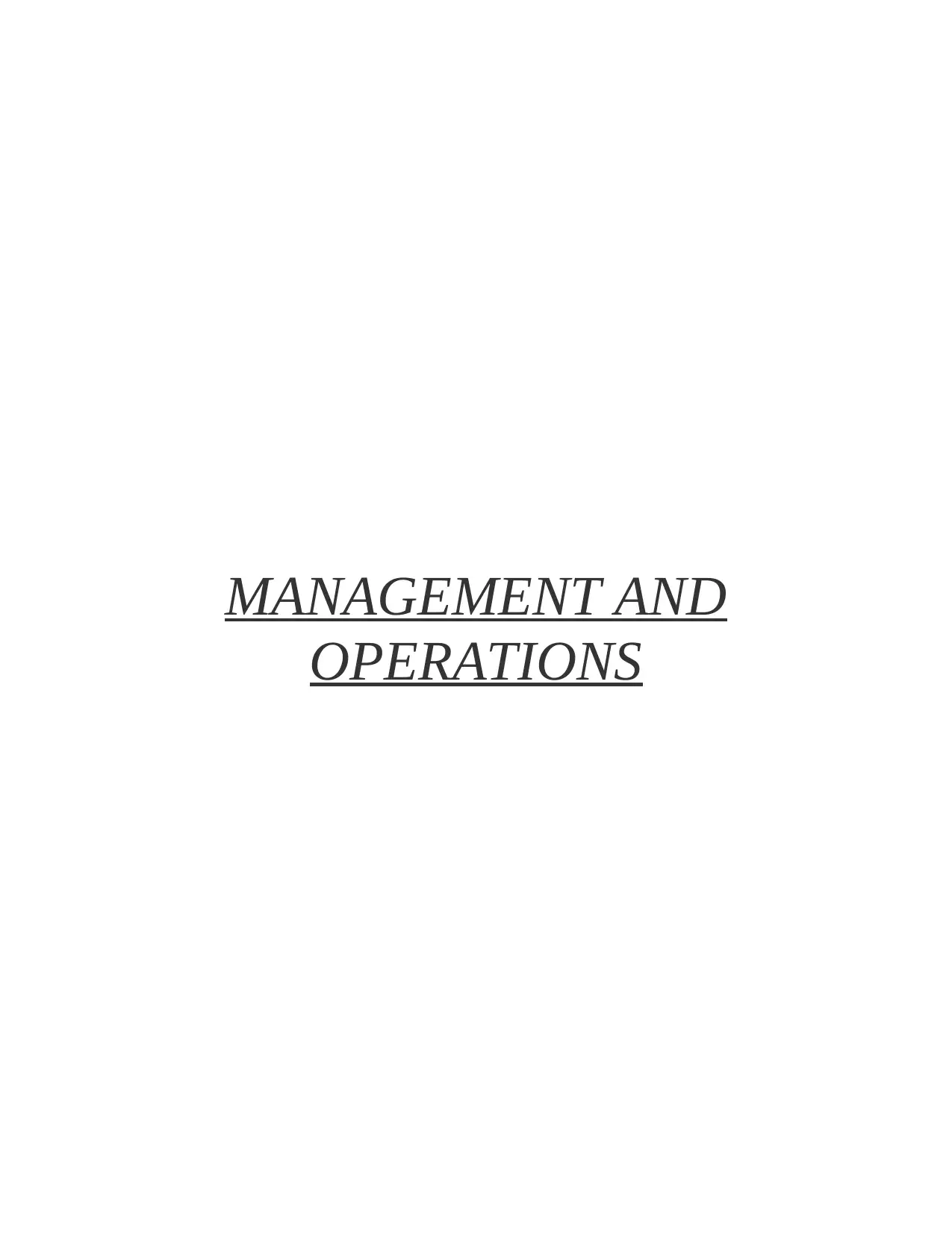
MANAGEMENT AND
OPERATIONS
OPERATIONS
Secure Best Marks with AI Grader
Need help grading? Try our AI Grader for instant feedback on your assignments.
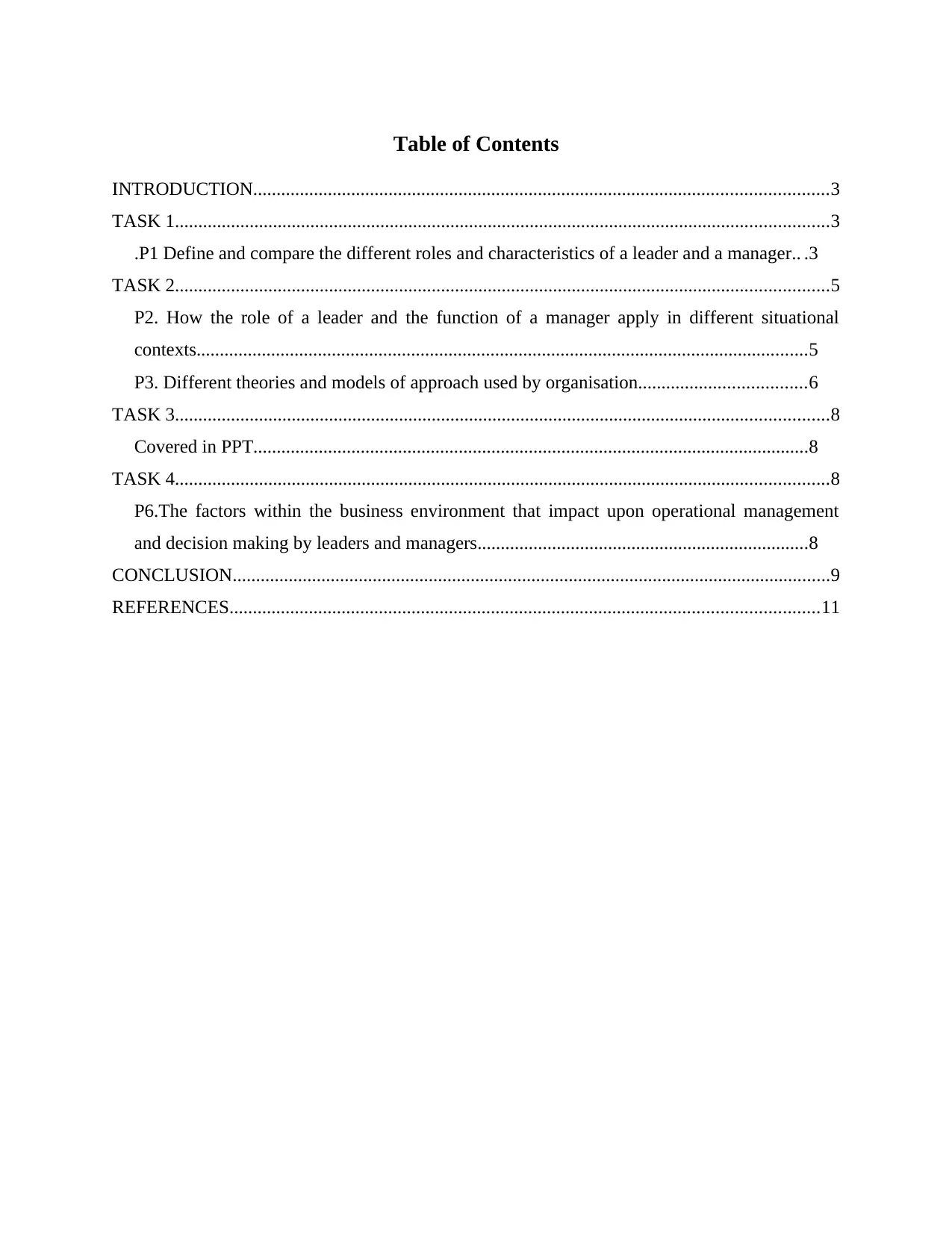
Table of Contents
INTRODUCTION...........................................................................................................................3
TASK 1............................................................................................................................................3
.P1 Define and compare the different roles and characteristics of a leader and a manager.. .3
TASK 2............................................................................................................................................5
P2. How the role of a leader and the function of a manager apply in different situational
contexts...................................................................................................................................5
P3. Different theories and models of approach used by organisation....................................6
TASK 3............................................................................................................................................8
Covered in PPT.......................................................................................................................8
TASK 4............................................................................................................................................8
P6.The factors within the business environment that impact upon operational management
and decision making by leaders and managers.......................................................................8
CONCLUSION................................................................................................................................9
REFERENCES..............................................................................................................................11
INTRODUCTION...........................................................................................................................3
TASK 1............................................................................................................................................3
.P1 Define and compare the different roles and characteristics of a leader and a manager.. .3
TASK 2............................................................................................................................................5
P2. How the role of a leader and the function of a manager apply in different situational
contexts...................................................................................................................................5
P3. Different theories and models of approach used by organisation....................................6
TASK 3............................................................................................................................................8
Covered in PPT.......................................................................................................................8
TASK 4............................................................................................................................................8
P6.The factors within the business environment that impact upon operational management
and decision making by leaders and managers.......................................................................8
CONCLUSION................................................................................................................................9
REFERENCES..............................................................................................................................11
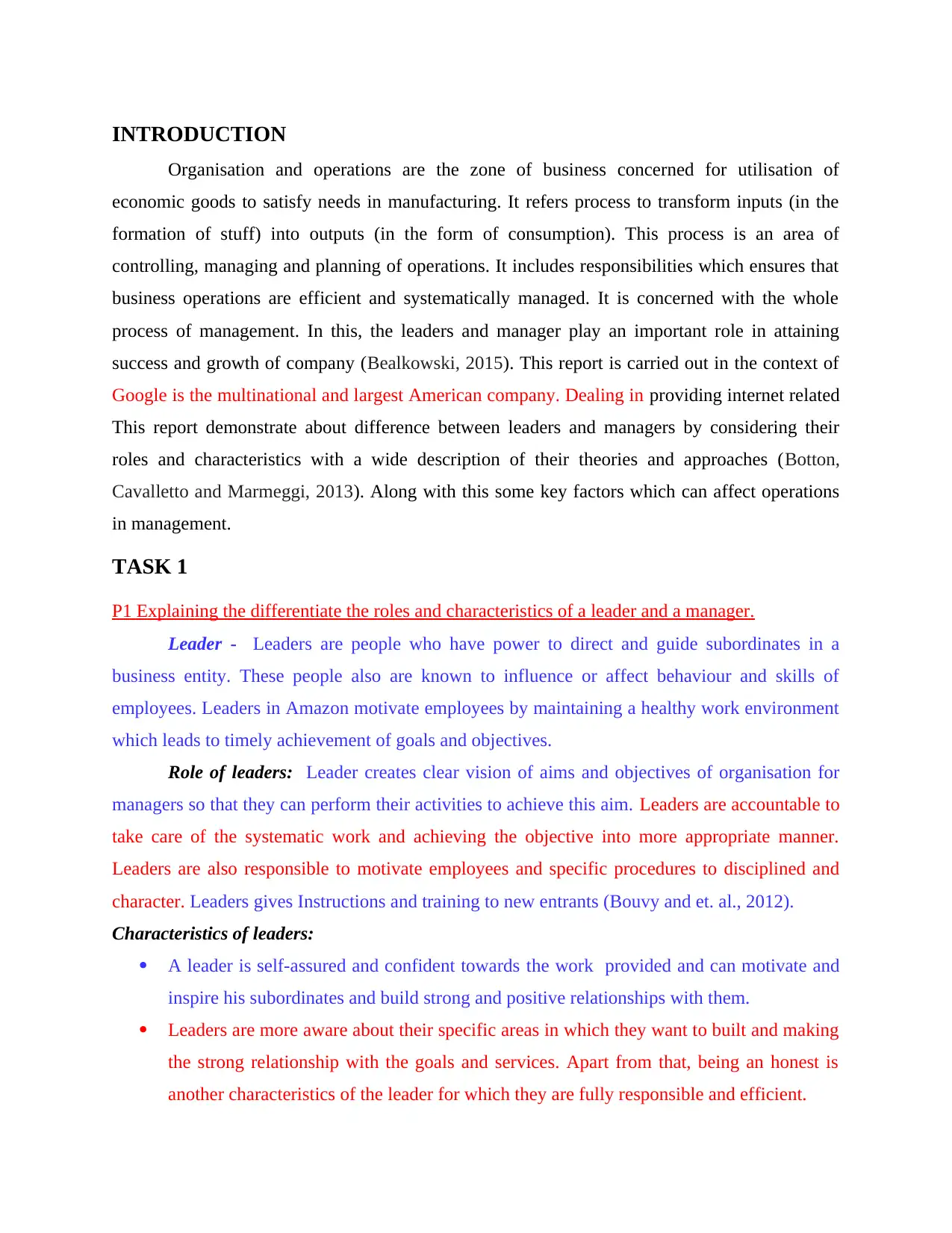
INTRODUCTION
Organisation and operations are the zone of business concerned for utilisation of
economic goods to satisfy needs in manufacturing. It refers process to transform inputs (in the
formation of stuff) into outputs (in the form of consumption). This process is an area of
controlling, managing and planning of operations. It includes responsibilities which ensures that
business operations are efficient and systematically managed. It is concerned with the whole
process of management. In this, the leaders and manager play an important role in attaining
success and growth of company (Bealkowski, 2015). This report is carried out in the context of
Google is the multinational and largest American company. Dealing in providing internet related
This report demonstrate about difference between leaders and managers by considering their
roles and characteristics with a wide description of their theories and approaches (Botton,
Cavalletto and Marmeggi, 2013). Along with this some key factors which can affect operations
in management.
TASK 1
P1 Explaining the differentiate the roles and characteristics of a leader and a manager.
Leader - Leaders are people who have power to direct and guide subordinates in a
business entity. These people also are known to influence or affect behaviour and skills of
employees. Leaders in Amazon motivate employees by maintaining a healthy work environment
which leads to timely achievement of goals and objectives.
Role of leaders: Leader creates clear vision of aims and objectives of organisation for
managers so that they can perform their activities to achieve this aim. Leaders are accountable to
take care of the systematic work and achieving the objective into more appropriate manner.
Leaders are also responsible to motivate employees and specific procedures to disciplined and
character. Leaders gives Instructions and training to new entrants (Bouvy and et. al., 2012).
Characteristics of leaders:
A leader is self-assured and confident towards the work provided and can motivate and
inspire his subordinates and build strong and positive relationships with them.
Leaders are more aware about their specific areas in which they want to built and making
the strong relationship with the goals and services. Apart from that, being an honest is
another characteristics of the leader for which they are fully responsible and efficient.
Organisation and operations are the zone of business concerned for utilisation of
economic goods to satisfy needs in manufacturing. It refers process to transform inputs (in the
formation of stuff) into outputs (in the form of consumption). This process is an area of
controlling, managing and planning of operations. It includes responsibilities which ensures that
business operations are efficient and systematically managed. It is concerned with the whole
process of management. In this, the leaders and manager play an important role in attaining
success and growth of company (Bealkowski, 2015). This report is carried out in the context of
Google is the multinational and largest American company. Dealing in providing internet related
This report demonstrate about difference between leaders and managers by considering their
roles and characteristics with a wide description of their theories and approaches (Botton,
Cavalletto and Marmeggi, 2013). Along with this some key factors which can affect operations
in management.
TASK 1
P1 Explaining the differentiate the roles and characteristics of a leader and a manager.
Leader - Leaders are people who have power to direct and guide subordinates in a
business entity. These people also are known to influence or affect behaviour and skills of
employees. Leaders in Amazon motivate employees by maintaining a healthy work environment
which leads to timely achievement of goals and objectives.
Role of leaders: Leader creates clear vision of aims and objectives of organisation for
managers so that they can perform their activities to achieve this aim. Leaders are accountable to
take care of the systematic work and achieving the objective into more appropriate manner.
Leaders are also responsible to motivate employees and specific procedures to disciplined and
character. Leaders gives Instructions and training to new entrants (Bouvy and et. al., 2012).
Characteristics of leaders:
A leader is self-assured and confident towards the work provided and can motivate and
inspire his subordinates and build strong and positive relationships with them.
Leaders are more aware about their specific areas in which they want to built and making
the strong relationship with the goals and services. Apart from that, being an honest is
another characteristics of the leader for which they are fully responsible and efficient.
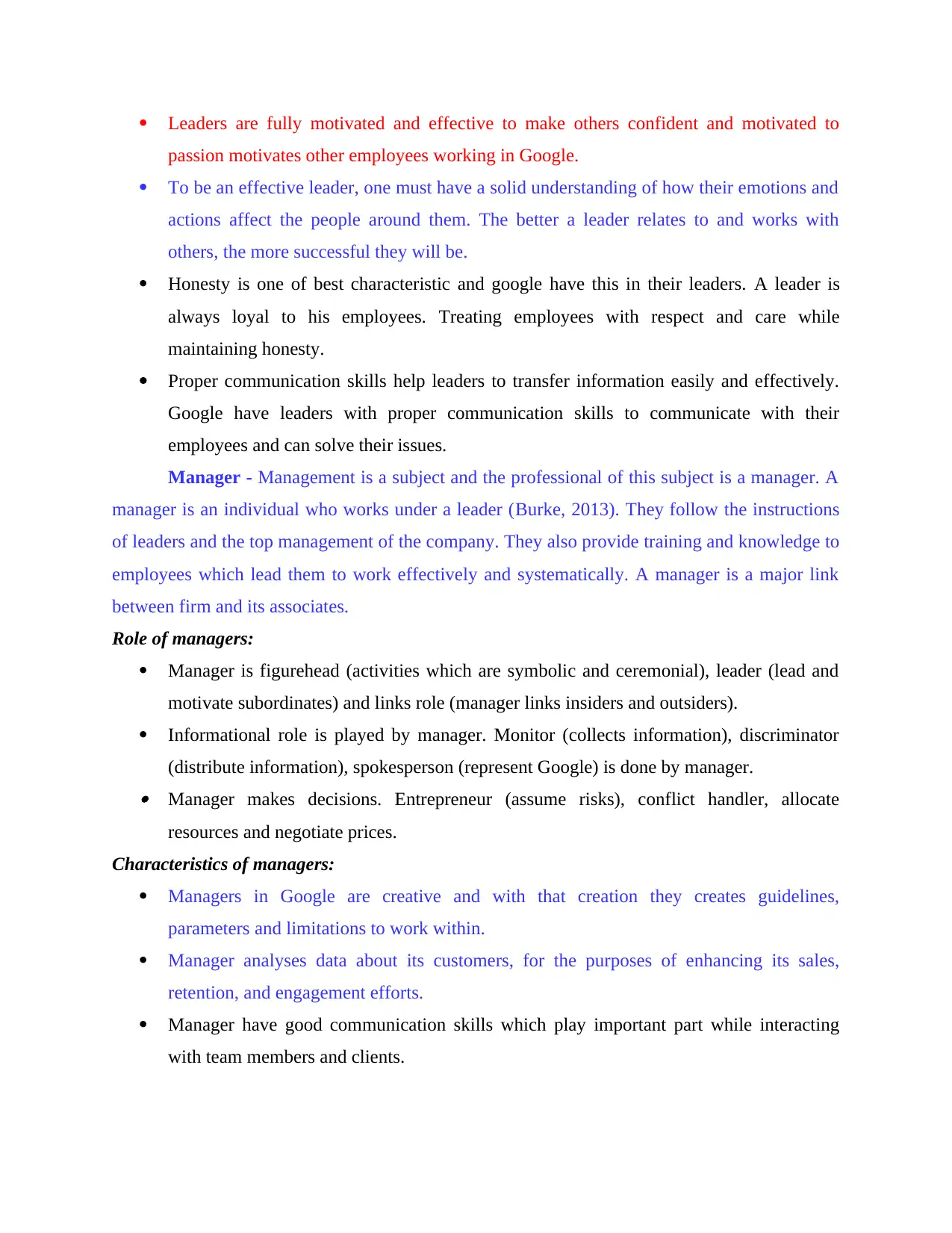
Leaders are fully motivated and effective to make others confident and motivated to
passion motivates other employees working in Google.
To be an effective leader, one must have a solid understanding of how their emotions and
actions affect the people around them. The better a leader relates to and works with
others, the more successful they will be.
Honesty is one of best characteristic and google have this in their leaders. A leader is
always loyal to his employees. Treating employees with respect and care while
maintaining honesty.
Proper communication skills help leaders to transfer information easily and effectively.
Google have leaders with proper communication skills to communicate with their
employees and can solve their issues.
Manager - Management is a subject and the professional of this subject is a manager. A
manager is an individual who works under a leader (Burke, 2013). They follow the instructions
of leaders and the top management of the company. They also provide training and knowledge to
employees which lead them to work effectively and systematically. A manager is a major link
between firm and its associates.
Role of managers:
Manager is figurehead (activities which are symbolic and ceremonial), leader (lead and
motivate subordinates) and links role (manager links insiders and outsiders).
Informational role is played by manager. Monitor (collects information), discriminator
(distribute information), spokesperson (represent Google) is done by manager. Manager makes decisions. Entrepreneur (assume risks), conflict handler, allocate
resources and negotiate prices.
Characteristics of managers:
Managers in Google are creative and with that creation they creates guidelines,
parameters and limitations to work within.
Manager analyses data about its customers, for the purposes of enhancing its sales,
retention, and engagement efforts.
Manager have good communication skills which play important part while interacting
with team members and clients.
passion motivates other employees working in Google.
To be an effective leader, one must have a solid understanding of how their emotions and
actions affect the people around them. The better a leader relates to and works with
others, the more successful they will be.
Honesty is one of best characteristic and google have this in their leaders. A leader is
always loyal to his employees. Treating employees with respect and care while
maintaining honesty.
Proper communication skills help leaders to transfer information easily and effectively.
Google have leaders with proper communication skills to communicate with their
employees and can solve their issues.
Manager - Management is a subject and the professional of this subject is a manager. A
manager is an individual who works under a leader (Burke, 2013). They follow the instructions
of leaders and the top management of the company. They also provide training and knowledge to
employees which lead them to work effectively and systematically. A manager is a major link
between firm and its associates.
Role of managers:
Manager is figurehead (activities which are symbolic and ceremonial), leader (lead and
motivate subordinates) and links role (manager links insiders and outsiders).
Informational role is played by manager. Monitor (collects information), discriminator
(distribute information), spokesperson (represent Google) is done by manager. Manager makes decisions. Entrepreneur (assume risks), conflict handler, allocate
resources and negotiate prices.
Characteristics of managers:
Managers in Google are creative and with that creation they creates guidelines,
parameters and limitations to work within.
Manager analyses data about its customers, for the purposes of enhancing its sales,
retention, and engagement efforts.
Manager have good communication skills which play important part while interacting
with team members and clients.
Secure Best Marks with AI Grader
Need help grading? Try our AI Grader for instant feedback on your assignments.
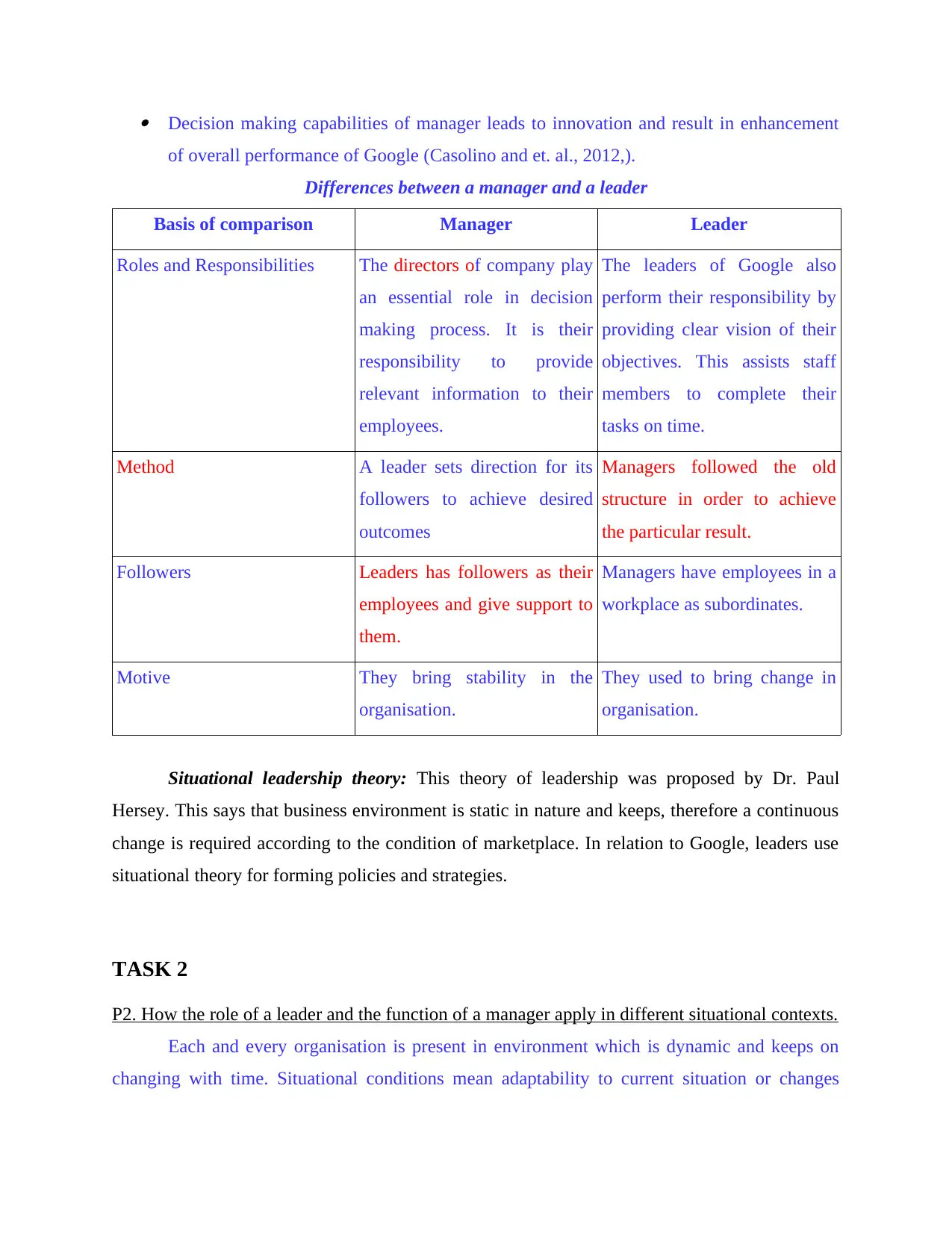
Decision making capabilities of manager leads to innovation and result in enhancement
of overall performance of Google (Casolino and et. al., 2012,).
Differences between a manager and a leader
Basis of comparison Manager Leader
Roles and Responsibilities The directors of company play
an essential role in decision
making process. It is their
responsibility to provide
relevant information to their
employees.
The leaders of Google also
perform their responsibility by
providing clear vision of their
objectives. This assists staff
members to complete their
tasks on time.
Method A leader sets direction for its
followers to achieve desired
outcomes
Managers followed the old
structure in order to achieve
the particular result.
Followers Leaders has followers as their
employees and give support to
them.
Managers have employees in a
workplace as subordinates.
Motive They bring stability in the
organisation.
They used to bring change in
organisation.
Situational leadership theory: This theory of leadership was proposed by Dr. Paul
Hersey. This says that business environment is static in nature and keeps, therefore a continuous
change is required according to the condition of marketplace. In relation to Google, leaders use
situational theory for forming policies and strategies.
TASK 2
P2. How the role of a leader and the function of a manager apply in different situational contexts.
Each and every organisation is present in environment which is dynamic and keeps on
changing with time. Situational conditions mean adaptability to current situation or changes
of overall performance of Google (Casolino and et. al., 2012,).
Differences between a manager and a leader
Basis of comparison Manager Leader
Roles and Responsibilities The directors of company play
an essential role in decision
making process. It is their
responsibility to provide
relevant information to their
employees.
The leaders of Google also
perform their responsibility by
providing clear vision of their
objectives. This assists staff
members to complete their
tasks on time.
Method A leader sets direction for its
followers to achieve desired
outcomes
Managers followed the old
structure in order to achieve
the particular result.
Followers Leaders has followers as their
employees and give support to
them.
Managers have employees in a
workplace as subordinates.
Motive They bring stability in the
organisation.
They used to bring change in
organisation.
Situational leadership theory: This theory of leadership was proposed by Dr. Paul
Hersey. This says that business environment is static in nature and keeps, therefore a continuous
change is required according to the condition of marketplace. In relation to Google, leaders use
situational theory for forming policies and strategies.
TASK 2
P2. How the role of a leader and the function of a manager apply in different situational contexts.
Each and every organisation is present in environment which is dynamic and keeps on
changing with time. Situational conditions mean adaptability to current situation or changes
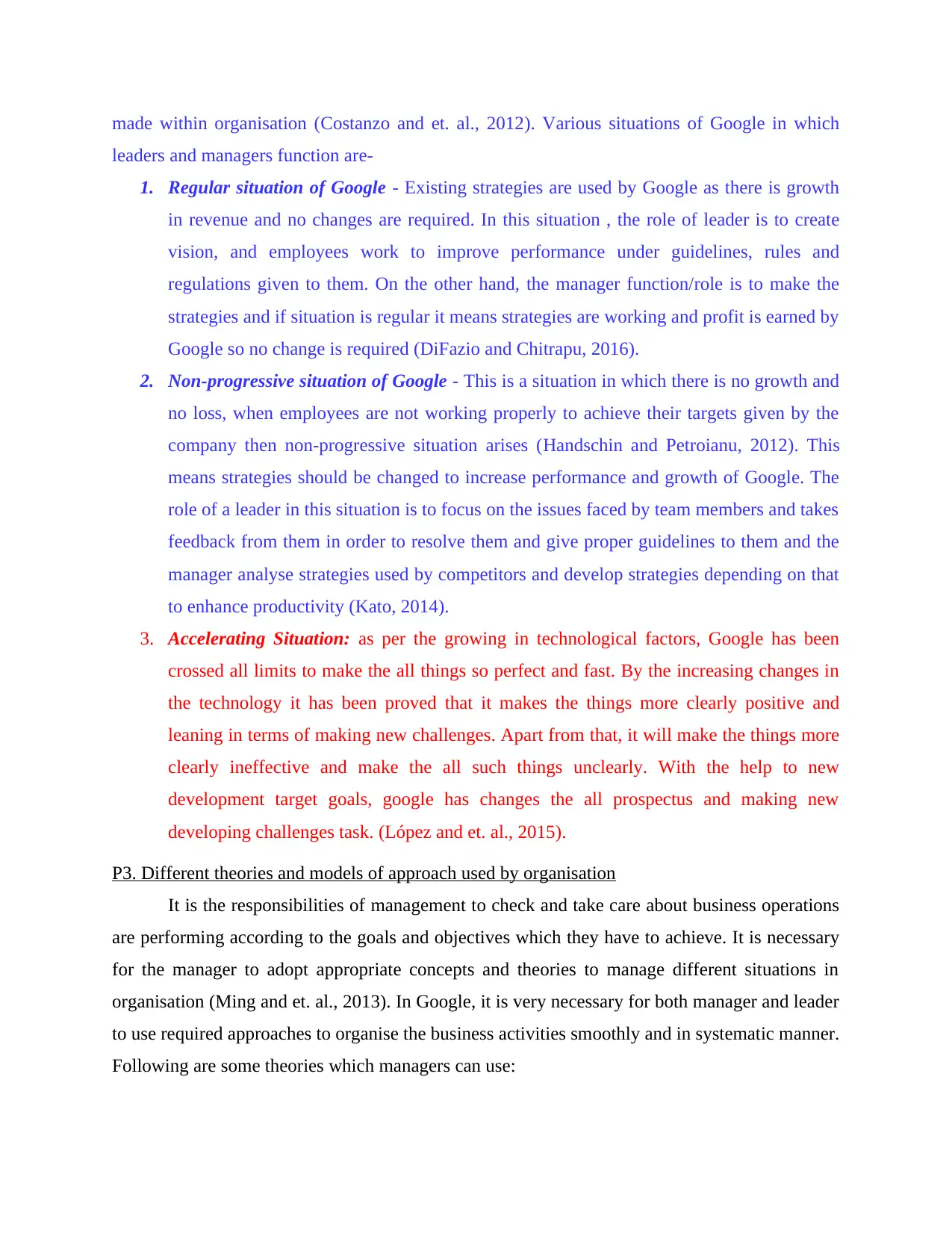
made within organisation (Costanzo and et. al., 2012). Various situations of Google in which
leaders and managers function are-
1. Regular situation of Google - Existing strategies are used by Google as there is growth
in revenue and no changes are required. In this situation , the role of leader is to create
vision, and employees work to improve performance under guidelines, rules and
regulations given to them. On the other hand, the manager function/role is to make the
strategies and if situation is regular it means strategies are working and profit is earned by
Google so no change is required (DiFazio and Chitrapu, 2016).
2. Non-progressive situation of Google - This is a situation in which there is no growth and
no loss, when employees are not working properly to achieve their targets given by the
company then non-progressive situation arises (Handschin and Petroianu, 2012). This
means strategies should be changed to increase performance and growth of Google. The
role of a leader in this situation is to focus on the issues faced by team members and takes
feedback from them in order to resolve them and give proper guidelines to them and the
manager analyse strategies used by competitors and develop strategies depending on that
to enhance productivity (Kato, 2014).
3. Accelerating Situation: as per the growing in technological factors, Google has been
crossed all limits to make the all things so perfect and fast. By the increasing changes in
the technology it has been proved that it makes the things more clearly positive and
leaning in terms of making new challenges. Apart from that, it will make the things more
clearly ineffective and make the all such things unclearly. With the help to new
development target goals, google has changes the all prospectus and making new
developing challenges task. (López and et. al., 2015).
P3. Different theories and models of approach used by organisation
It is the responsibilities of management to check and take care about business operations
are performing according to the goals and objectives which they have to achieve. It is necessary
for the manager to adopt appropriate concepts and theories to manage different situations in
organisation (Ming and et. al., 2013). In Google, it is very necessary for both manager and leader
to use required approaches to organise the business activities smoothly and in systematic manner.
Following are some theories which managers can use:
leaders and managers function are-
1. Regular situation of Google - Existing strategies are used by Google as there is growth
in revenue and no changes are required. In this situation , the role of leader is to create
vision, and employees work to improve performance under guidelines, rules and
regulations given to them. On the other hand, the manager function/role is to make the
strategies and if situation is regular it means strategies are working and profit is earned by
Google so no change is required (DiFazio and Chitrapu, 2016).
2. Non-progressive situation of Google - This is a situation in which there is no growth and
no loss, when employees are not working properly to achieve their targets given by the
company then non-progressive situation arises (Handschin and Petroianu, 2012). This
means strategies should be changed to increase performance and growth of Google. The
role of a leader in this situation is to focus on the issues faced by team members and takes
feedback from them in order to resolve them and give proper guidelines to them and the
manager analyse strategies used by competitors and develop strategies depending on that
to enhance productivity (Kato, 2014).
3. Accelerating Situation: as per the growing in technological factors, Google has been
crossed all limits to make the all things so perfect and fast. By the increasing changes in
the technology it has been proved that it makes the things more clearly positive and
leaning in terms of making new challenges. Apart from that, it will make the things more
clearly ineffective and make the all such things unclearly. With the help to new
development target goals, google has changes the all prospectus and making new
developing challenges task. (López and et. al., 2015).
P3. Different theories and models of approach used by organisation
It is the responsibilities of management to check and take care about business operations
are performing according to the goals and objectives which they have to achieve. It is necessary
for the manager to adopt appropriate concepts and theories to manage different situations in
organisation (Ming and et. al., 2013). In Google, it is very necessary for both manager and leader
to use required approaches to organise the business activities smoothly and in systematic manner.
Following are some theories which managers can use:
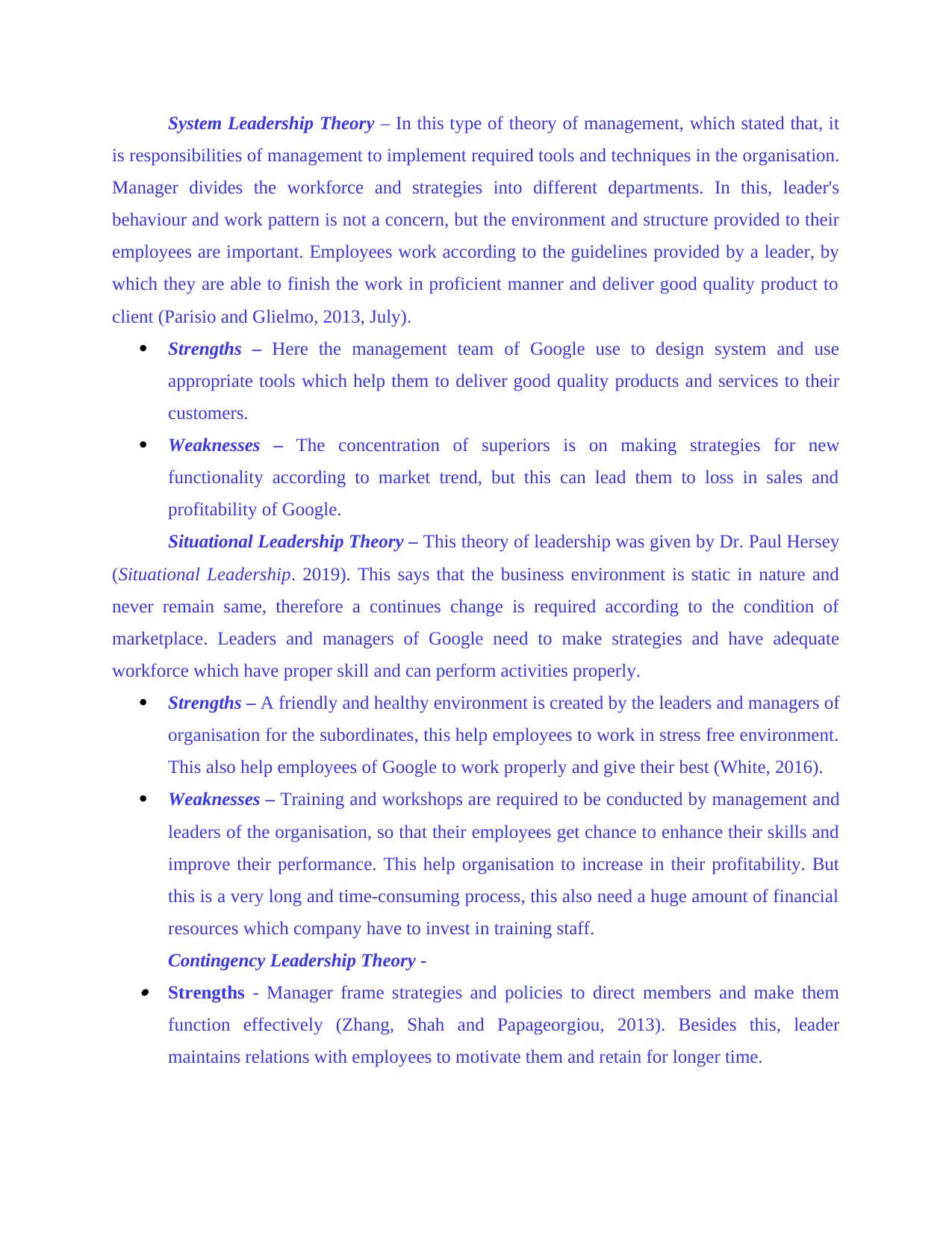
System Leadership Theory – In this type of theory of management, which stated that, it
is responsibilities of management to implement required tools and techniques in the organisation.
Manager divides the workforce and strategies into different departments. In this, leader's
behaviour and work pattern is not a concern, but the environment and structure provided to their
employees are important. Employees work according to the guidelines provided by a leader, by
which they are able to finish the work in proficient manner and deliver good quality product to
client (Parisio and Glielmo, 2013, July).
Strengths – Here the management team of Google use to design system and use
appropriate tools which help them to deliver good quality products and services to their
customers.
Weaknesses – The concentration of superiors is on making strategies for new
functionality according to market trend, but this can lead them to loss in sales and
profitability of Google.
Situational Leadership Theory – This theory of leadership was given by Dr. Paul Hersey
(Situational Leadership. 2019). This says that the business environment is static in nature and
never remain same, therefore a continues change is required according to the condition of
marketplace. Leaders and managers of Google need to make strategies and have adequate
workforce which have proper skill and can perform activities properly.
Strengths – A friendly and healthy environment is created by the leaders and managers of
organisation for the subordinates, this help employees to work in stress free environment.
This also help employees of Google to work properly and give their best (White, 2016).
Weaknesses – Training and workshops are required to be conducted by management and
leaders of the organisation, so that their employees get chance to enhance their skills and
improve their performance. This help organisation to increase in their profitability. But
this is a very long and time-consuming process, this also need a huge amount of financial
resources which company have to invest in training staff.
Contingency Leadership Theory - Strengths - Manager frame strategies and policies to direct members and make them
function effectively (Zhang, Shah and Papageorgiou, 2013). Besides this, leader
maintains relations with employees to motivate them and retain for longer time.
is responsibilities of management to implement required tools and techniques in the organisation.
Manager divides the workforce and strategies into different departments. In this, leader's
behaviour and work pattern is not a concern, but the environment and structure provided to their
employees are important. Employees work according to the guidelines provided by a leader, by
which they are able to finish the work in proficient manner and deliver good quality product to
client (Parisio and Glielmo, 2013, July).
Strengths – Here the management team of Google use to design system and use
appropriate tools which help them to deliver good quality products and services to their
customers.
Weaknesses – The concentration of superiors is on making strategies for new
functionality according to market trend, but this can lead them to loss in sales and
profitability of Google.
Situational Leadership Theory – This theory of leadership was given by Dr. Paul Hersey
(Situational Leadership. 2019). This says that the business environment is static in nature and
never remain same, therefore a continues change is required according to the condition of
marketplace. Leaders and managers of Google need to make strategies and have adequate
workforce which have proper skill and can perform activities properly.
Strengths – A friendly and healthy environment is created by the leaders and managers of
organisation for the subordinates, this help employees to work in stress free environment.
This also help employees of Google to work properly and give their best (White, 2016).
Weaknesses – Training and workshops are required to be conducted by management and
leaders of the organisation, so that their employees get chance to enhance their skills and
improve their performance. This help organisation to increase in their profitability. But
this is a very long and time-consuming process, this also need a huge amount of financial
resources which company have to invest in training staff.
Contingency Leadership Theory - Strengths - Manager frame strategies and policies to direct members and make them
function effectively (Zhang, Shah and Papageorgiou, 2013). Besides this, leader
maintains relations with employees to motivate them and retain for longer time.
Paraphrase This Document
Need a fresh take? Get an instant paraphrase of this document with our AI Paraphraser
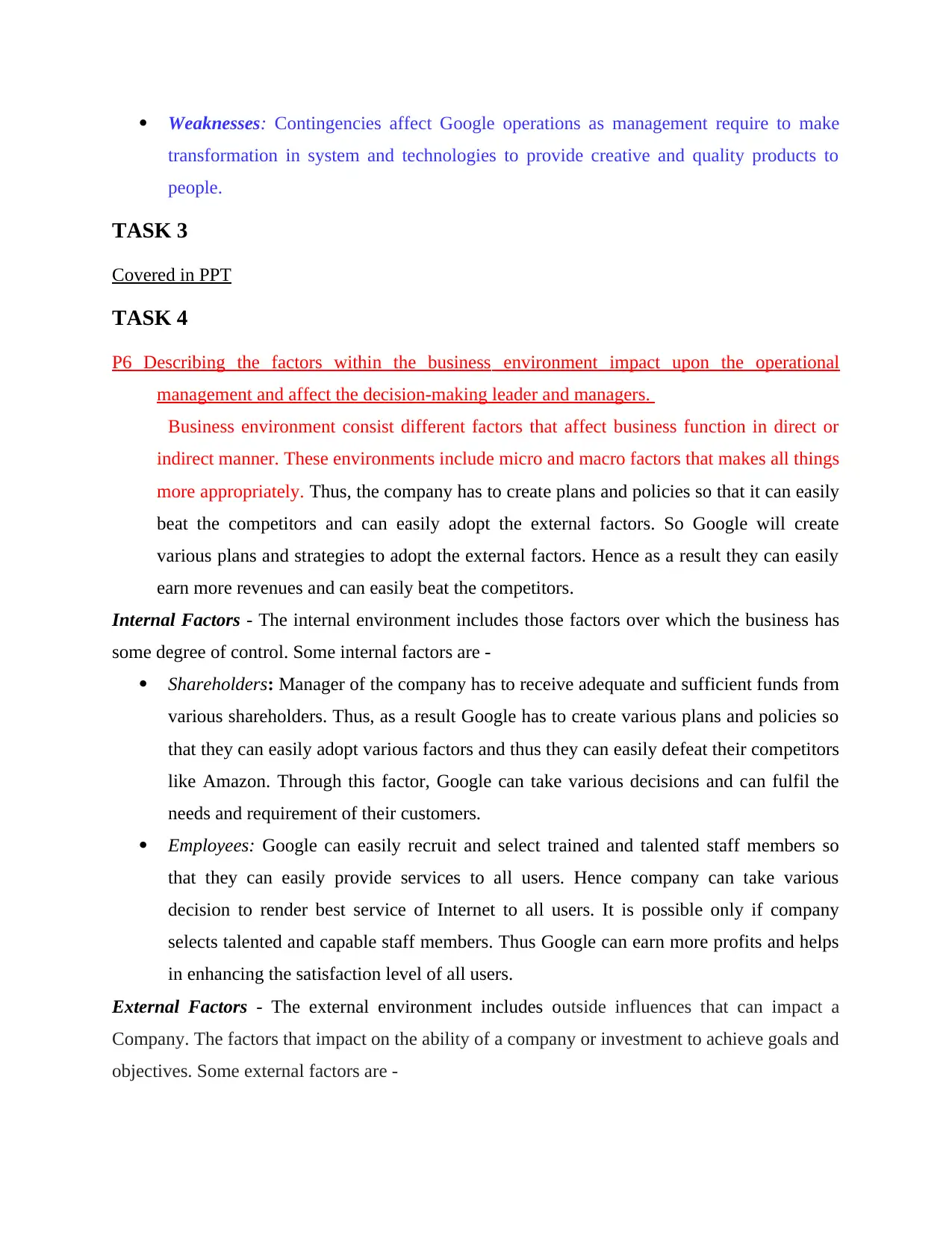
Weaknesses: Contingencies affect Google operations as management require to make
transformation in system and technologies to provide creative and quality products to
people.
TASK 3
Covered in PPT
TASK 4
P6 Describing the factors within the business environment impact upon the operational
management and affect the decision-making leader and managers.
Business environment consist different factors that affect business function in direct or
indirect manner. These environments include micro and macro factors that makes all things
more appropriately. Thus, the company has to create plans and policies so that it can easily
beat the competitors and can easily adopt the external factors. So Google will create
various plans and strategies to adopt the external factors. Hence as a result they can easily
earn more revenues and can easily beat the competitors.
Internal Factors - The internal environment includes those factors over which the business has
some degree of control. Some internal factors are -
Shareholders: Manager of the company has to receive adequate and sufficient funds from
various shareholders. Thus, as a result Google has to create various plans and policies so
that they can easily adopt various factors and thus they can easily defeat their competitors
like Amazon. Through this factor, Google can take various decisions and can fulfil the
needs and requirement of their customers.
Employees: Google can easily recruit and select trained and talented staff members so
that they can easily provide services to all users. Hence company can take various
decision to render best service of Internet to all users. It is possible only if company
selects talented and capable staff members. Thus Google can earn more profits and helps
in enhancing the satisfaction level of all users.
External Factors - The external environment includes outside influences that can impact a
Company. The factors that impact on the ability of a company or investment to achieve goals and
objectives. Some external factors are -
transformation in system and technologies to provide creative and quality products to
people.
TASK 3
Covered in PPT
TASK 4
P6 Describing the factors within the business environment impact upon the operational
management and affect the decision-making leader and managers.
Business environment consist different factors that affect business function in direct or
indirect manner. These environments include micro and macro factors that makes all things
more appropriately. Thus, the company has to create plans and policies so that it can easily
beat the competitors and can easily adopt the external factors. So Google will create
various plans and strategies to adopt the external factors. Hence as a result they can easily
earn more revenues and can easily beat the competitors.
Internal Factors - The internal environment includes those factors over which the business has
some degree of control. Some internal factors are -
Shareholders: Manager of the company has to receive adequate and sufficient funds from
various shareholders. Thus, as a result Google has to create various plans and policies so
that they can easily adopt various factors and thus they can easily defeat their competitors
like Amazon. Through this factor, Google can take various decisions and can fulfil the
needs and requirement of their customers.
Employees: Google can easily recruit and select trained and talented staff members so
that they can easily provide services to all users. Hence company can take various
decision to render best service of Internet to all users. It is possible only if company
selects talented and capable staff members. Thus Google can earn more profits and helps
in enhancing the satisfaction level of all users.
External Factors - The external environment includes outside influences that can impact a
Company. The factors that impact on the ability of a company or investment to achieve goals and
objectives. Some external factors are -
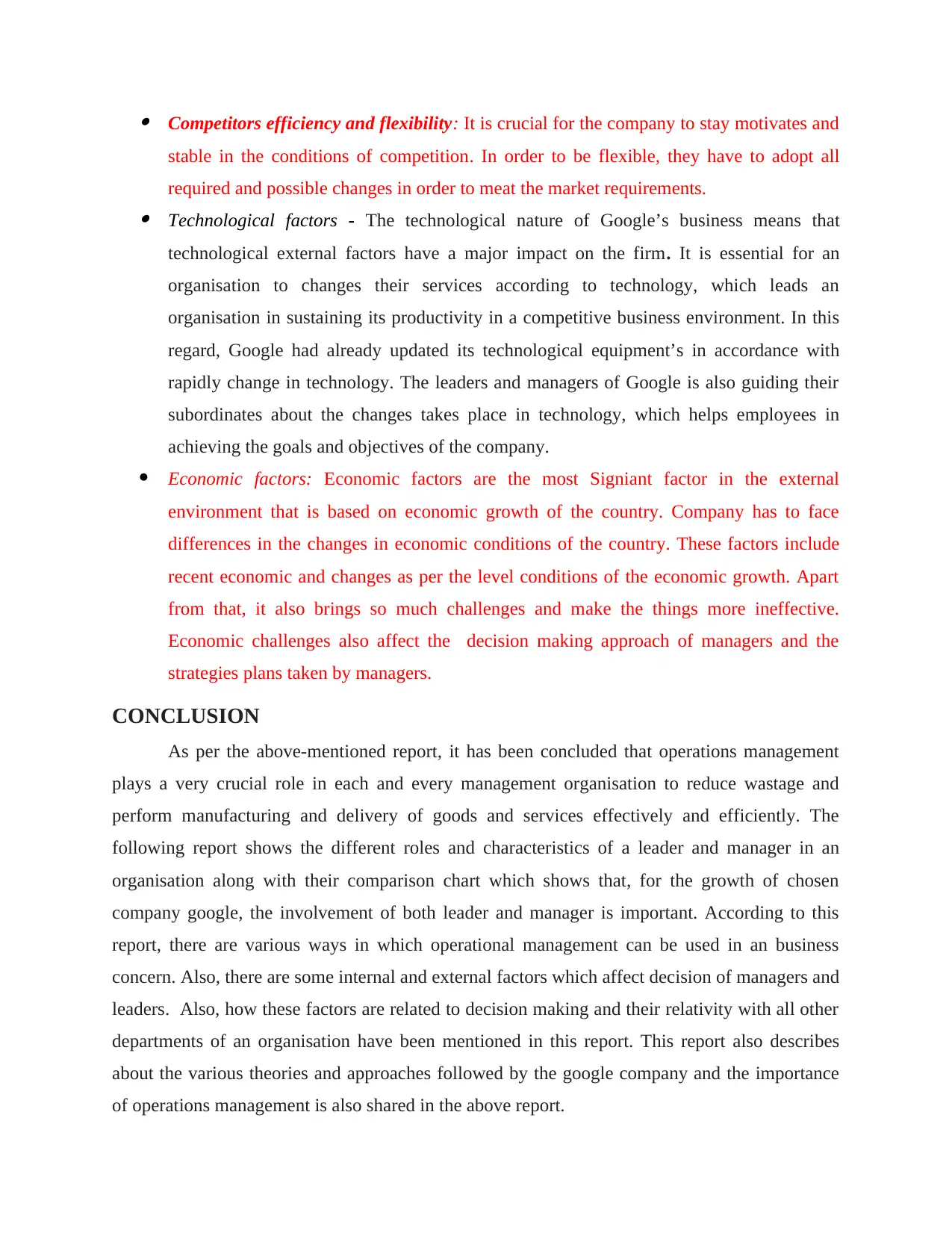
Competitors efficiency and flexibility: It is crucial for the company to stay motivates and
stable in the conditions of competition. In order to be flexible, they have to adopt all
required and possible changes in order to meat the market requirements. Technological factors - The technological nature of Google’s business means that
technological external factors have a major impact on the firm. It is essential for an
organisation to changes their services according to technology, which leads an
organisation in sustaining its productivity in a competitive business environment. In this
regard, Google had already updated its technological equipment’s in accordance with
rapidly change in technology. The leaders and managers of Google is also guiding their
subordinates about the changes takes place in technology, which helps employees in
achieving the goals and objectives of the company.
Economic factors: Economic factors are the most Signiant factor in the external
environment that is based on economic growth of the country. Company has to face
differences in the changes in economic conditions of the country. These factors include
recent economic and changes as per the level conditions of the economic growth. Apart
from that, it also brings so much challenges and make the things more ineffective.
Economic challenges also affect the decision making approach of managers and the
strategies plans taken by managers.
CONCLUSION
As per the above-mentioned report, it has been concluded that operations management
plays a very crucial role in each and every management organisation to reduce wastage and
perform manufacturing and delivery of goods and services effectively and efficiently. The
following report shows the different roles and characteristics of a leader and manager in an
organisation along with their comparison chart which shows that, for the growth of chosen
company google, the involvement of both leader and manager is important. According to this
report, there are various ways in which operational management can be used in an business
concern. Also, there are some internal and external factors which affect decision of managers and
leaders. Also, how these factors are related to decision making and their relativity with all other
departments of an organisation have been mentioned in this report. This report also describes
about the various theories and approaches followed by the google company and the importance
of operations management is also shared in the above report.
stable in the conditions of competition. In order to be flexible, they have to adopt all
required and possible changes in order to meat the market requirements. Technological factors - The technological nature of Google’s business means that
technological external factors have a major impact on the firm. It is essential for an
organisation to changes their services according to technology, which leads an
organisation in sustaining its productivity in a competitive business environment. In this
regard, Google had already updated its technological equipment’s in accordance with
rapidly change in technology. The leaders and managers of Google is also guiding their
subordinates about the changes takes place in technology, which helps employees in
achieving the goals and objectives of the company.
Economic factors: Economic factors are the most Signiant factor in the external
environment that is based on economic growth of the country. Company has to face
differences in the changes in economic conditions of the country. These factors include
recent economic and changes as per the level conditions of the economic growth. Apart
from that, it also brings so much challenges and make the things more ineffective.
Economic challenges also affect the decision making approach of managers and the
strategies plans taken by managers.
CONCLUSION
As per the above-mentioned report, it has been concluded that operations management
plays a very crucial role in each and every management organisation to reduce wastage and
perform manufacturing and delivery of goods and services effectively and efficiently. The
following report shows the different roles and characteristics of a leader and manager in an
organisation along with their comparison chart which shows that, for the growth of chosen
company google, the involvement of both leader and manager is important. According to this
report, there are various ways in which operational management can be used in an business
concern. Also, there are some internal and external factors which affect decision of managers and
leaders. Also, how these factors are related to decision making and their relativity with all other
departments of an organisation have been mentioned in this report. This report also describes
about the various theories and approaches followed by the google company and the importance
of operations management is also shared in the above report.

Secure Best Marks with AI Grader
Need help grading? Try our AI Grader for instant feedback on your assignments.
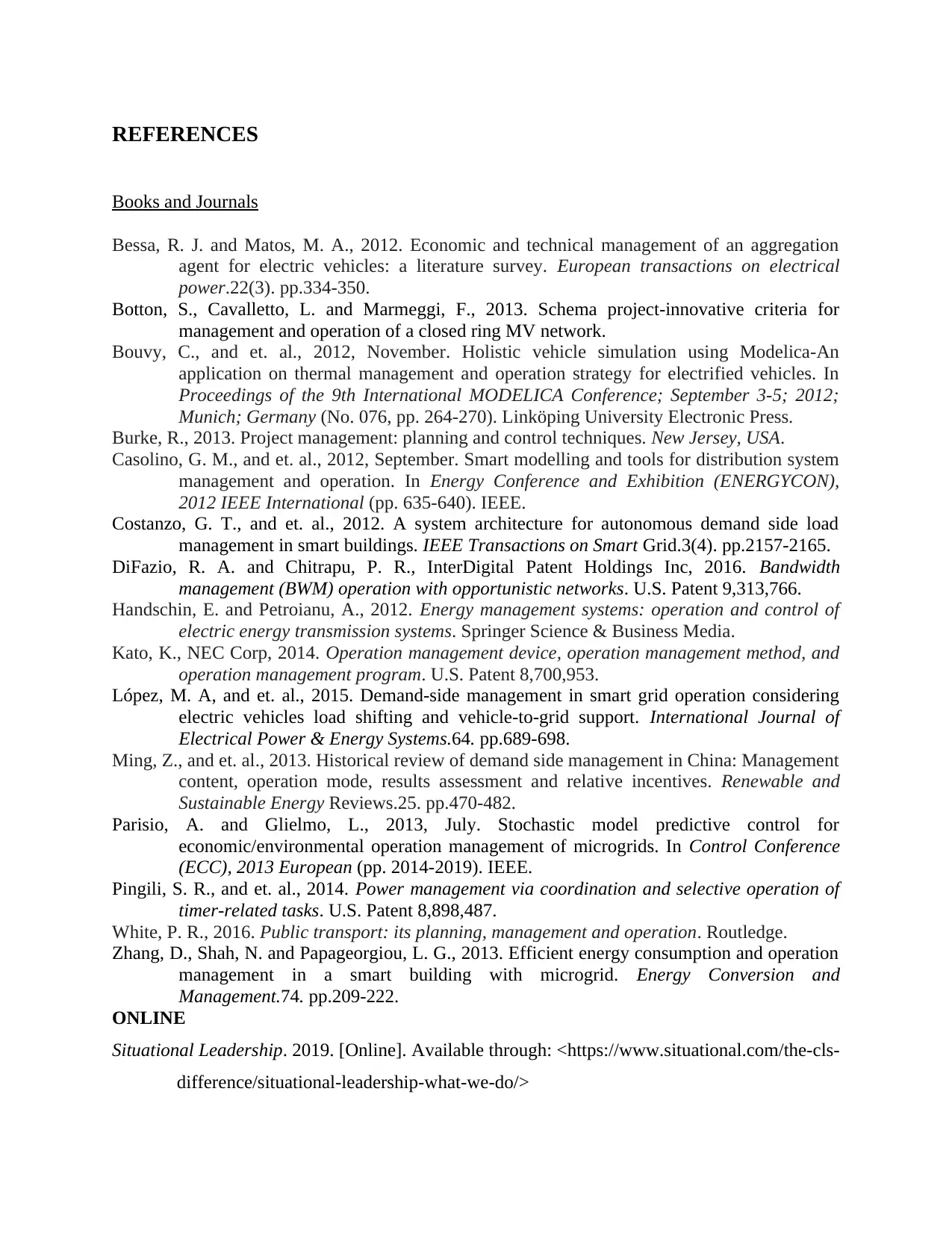
REFERENCES
Books and Journals
Bessa, R. J. and Matos, M. A., 2012. Economic and technical management of an aggregation
agent for electric vehicles: a literature survey. European transactions on electrical
power.22(3). pp.334-350.
Botton, S., Cavalletto, L. and Marmeggi, F., 2013. Schema project-innovative criteria for
management and operation of a closed ring MV network.
Bouvy, C., and et. al., 2012, November. Holistic vehicle simulation using Modelica-An
application on thermal management and operation strategy for electrified vehicles. In
Proceedings of the 9th International MODELICA Conference; September 3-5; 2012;
Munich; Germany (No. 076, pp. 264-270). Linköping University Electronic Press.
Burke, R., 2013. Project management: planning and control techniques. New Jersey, USA.
Casolino, G. M., and et. al., 2012, September. Smart modelling and tools for distribution system
management and operation. In Energy Conference and Exhibition (ENERGYCON),
2012 IEEE International (pp. 635-640). IEEE.
Costanzo, G. T., and et. al., 2012. A system architecture for autonomous demand side load
management in smart buildings. IEEE Transactions on Smart Grid.3(4). pp.2157-2165.
DiFazio, R. A. and Chitrapu, P. R., InterDigital Patent Holdings Inc, 2016. Bandwidth
management (BWM) operation with opportunistic networks. U.S. Patent 9,313,766.
Handschin, E. and Petroianu, A., 2012. Energy management systems: operation and control of
electric energy transmission systems. Springer Science & Business Media.
Kato, K., NEC Corp, 2014. Operation management device, operation management method, and
operation management program. U.S. Patent 8,700,953.
López, M. A, and et. al., 2015. Demand-side management in smart grid operation considering
electric vehicles load shifting and vehicle-to-grid support. International Journal of
Electrical Power & Energy Systems.64. pp.689-698.
Ming, Z., and et. al., 2013. Historical review of demand side management in China: Management
content, operation mode, results assessment and relative incentives. Renewable and
Sustainable Energy Reviews.25. pp.470-482.
Parisio, A. and Glielmo, L., 2013, July. Stochastic model predictive control for
economic/environmental operation management of microgrids. In Control Conference
(ECC), 2013 European (pp. 2014-2019). IEEE.
Pingili, S. R., and et. al., 2014. Power management via coordination and selective operation of
timer-related tasks. U.S. Patent 8,898,487.
White, P. R., 2016. Public transport: its planning, management and operation. Routledge.
Zhang, D., Shah, N. and Papageorgiou, L. G., 2013. Efficient energy consumption and operation
management in a smart building with microgrid. Energy Conversion and
Management.74. pp.209-222.
ONLINE
Situational Leadership. 2019. [Online]. Available through: <https://www.situational.com/the-cls-
difference/situational-leadership-what-we-do/>
Books and Journals
Bessa, R. J. and Matos, M. A., 2012. Economic and technical management of an aggregation
agent for electric vehicles: a literature survey. European transactions on electrical
power.22(3). pp.334-350.
Botton, S., Cavalletto, L. and Marmeggi, F., 2013. Schema project-innovative criteria for
management and operation of a closed ring MV network.
Bouvy, C., and et. al., 2012, November. Holistic vehicle simulation using Modelica-An
application on thermal management and operation strategy for electrified vehicles. In
Proceedings of the 9th International MODELICA Conference; September 3-5; 2012;
Munich; Germany (No. 076, pp. 264-270). Linköping University Electronic Press.
Burke, R., 2013. Project management: planning and control techniques. New Jersey, USA.
Casolino, G. M., and et. al., 2012, September. Smart modelling and tools for distribution system
management and operation. In Energy Conference and Exhibition (ENERGYCON),
2012 IEEE International (pp. 635-640). IEEE.
Costanzo, G. T., and et. al., 2012. A system architecture for autonomous demand side load
management in smart buildings. IEEE Transactions on Smart Grid.3(4). pp.2157-2165.
DiFazio, R. A. and Chitrapu, P. R., InterDigital Patent Holdings Inc, 2016. Bandwidth
management (BWM) operation with opportunistic networks. U.S. Patent 9,313,766.
Handschin, E. and Petroianu, A., 2012. Energy management systems: operation and control of
electric energy transmission systems. Springer Science & Business Media.
Kato, K., NEC Corp, 2014. Operation management device, operation management method, and
operation management program. U.S. Patent 8,700,953.
López, M. A, and et. al., 2015. Demand-side management in smart grid operation considering
electric vehicles load shifting and vehicle-to-grid support. International Journal of
Electrical Power & Energy Systems.64. pp.689-698.
Ming, Z., and et. al., 2013. Historical review of demand side management in China: Management
content, operation mode, results assessment and relative incentives. Renewable and
Sustainable Energy Reviews.25. pp.470-482.
Parisio, A. and Glielmo, L., 2013, July. Stochastic model predictive control for
economic/environmental operation management of microgrids. In Control Conference
(ECC), 2013 European (pp. 2014-2019). IEEE.
Pingili, S. R., and et. al., 2014. Power management via coordination and selective operation of
timer-related tasks. U.S. Patent 8,898,487.
White, P. R., 2016. Public transport: its planning, management and operation. Routledge.
Zhang, D., Shah, N. and Papageorgiou, L. G., 2013. Efficient energy consumption and operation
management in a smart building with microgrid. Energy Conversion and
Management.74. pp.209-222.
ONLINE
Situational Leadership. 2019. [Online]. Available through: <https://www.situational.com/the-cls-
difference/situational-leadership-what-we-do/>

1 out of 12
Related Documents
Your All-in-One AI-Powered Toolkit for Academic Success.
+13062052269
info@desklib.com
Available 24*7 on WhatsApp / Email
![[object Object]](/_next/static/media/star-bottom.7253800d.svg)
Unlock your academic potential
© 2024 | Zucol Services PVT LTD | All rights reserved.





